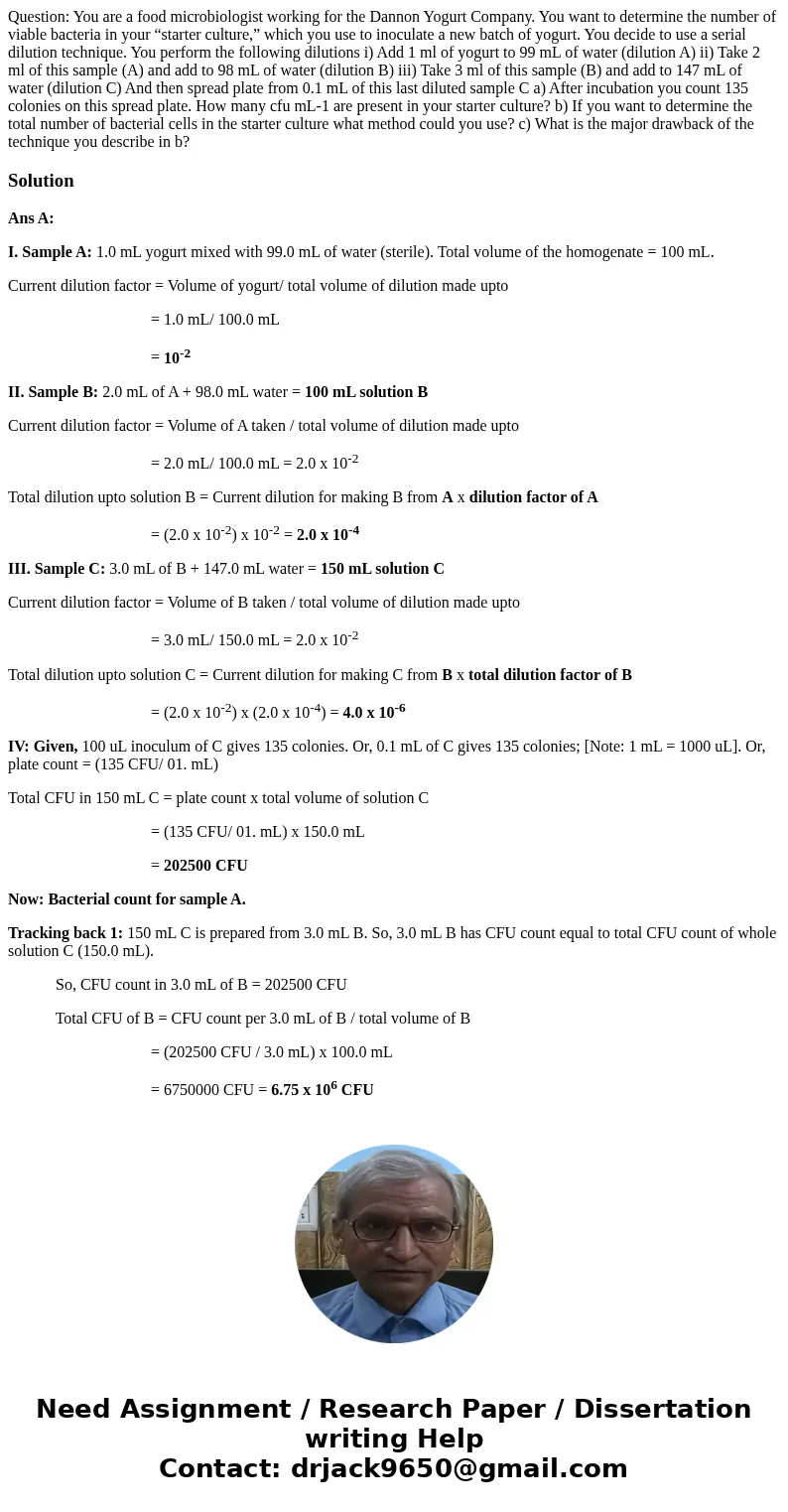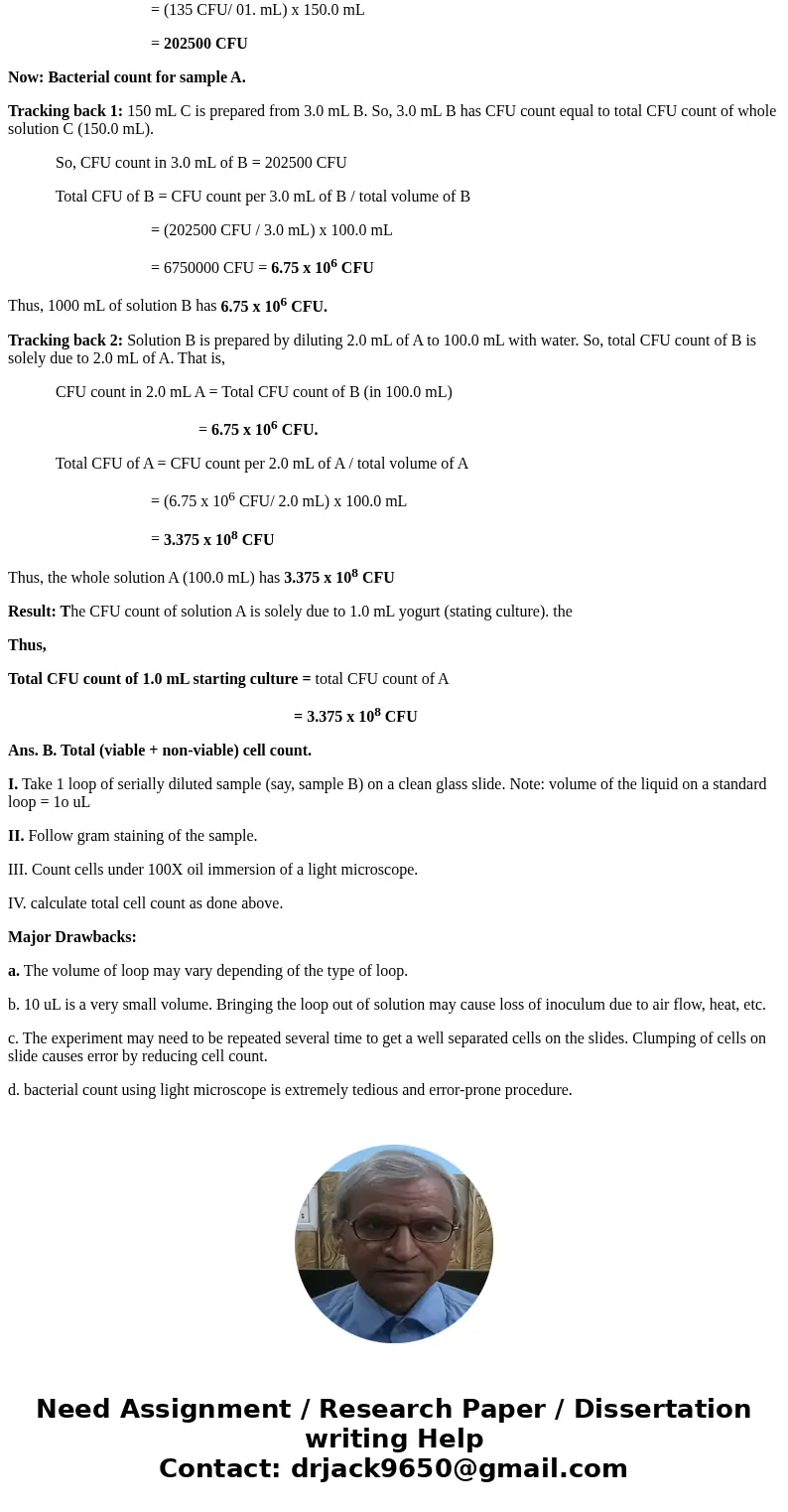Question You are a food microbiologist working for the Danno
Question: You are a food microbiologist working for the Dannon Yogurt Company. You want to determine the number of viable bacteria in your “starter culture,” which you use to inoculate a new batch of yogurt. You decide to use a serial dilution technique. You perform the following dilutions i) Add 1 ml of yogurt to 99 mL of water (dilution A) ii) Take 2 ml of this sample (A) and add to 98 mL of water (dilution B) iii) Take 3 ml of this sample (B) and add to 147 mL of water (dilution C) And then spread plate from 0.1 mL of this last diluted sample C a) After incubation you count 135 colonies on this spread plate. How many cfu mL-1 are present in your starter culture? b) If you want to determine the total number of bacterial cells in the starter culture what method could you use? c) What is the major drawback of the technique you describe in b?
Solution
Ans A:
I. Sample A: 1.0 mL yogurt mixed with 99.0 mL of water (sterile). Total volume of the homogenate = 100 mL.
Current dilution factor = Volume of yogurt/ total volume of dilution made upto
= 1.0 mL/ 100.0 mL
= 10-2
II. Sample B: 2.0 mL of A + 98.0 mL water = 100 mL solution B
Current dilution factor = Volume of A taken / total volume of dilution made upto
= 2.0 mL/ 100.0 mL = 2.0 x 10-2
Total dilution upto solution B = Current dilution for making B from A x dilution factor of A
= (2.0 x 10-2) x 10-2 = 2.0 x 10-4
III. Sample C: 3.0 mL of B + 147.0 mL water = 150 mL solution C
Current dilution factor = Volume of B taken / total volume of dilution made upto
= 3.0 mL/ 150.0 mL = 2.0 x 10-2
Total dilution upto solution C = Current dilution for making C from B x total dilution factor of B
= (2.0 x 10-2) x (2.0 x 10-4) = 4.0 x 10-6
IV: Given, 100 uL inoculum of C gives 135 colonies. Or, 0.1 mL of C gives 135 colonies; [Note: 1 mL = 1000 uL]. Or, plate count = (135 CFU/ 01. mL)
Total CFU in 150 mL C = plate count x total volume of solution C
= (135 CFU/ 01. mL) x 150.0 mL
= 202500 CFU
Now: Bacterial count for sample A.
Tracking back 1: 150 mL C is prepared from 3.0 mL B. So, 3.0 mL B has CFU count equal to total CFU count of whole solution C (150.0 mL).
So, CFU count in 3.0 mL of B = 202500 CFU
Total CFU of B = CFU count per 3.0 mL of B / total volume of B
= (202500 CFU / 3.0 mL) x 100.0 mL
= 6750000 CFU = 6.75 x 106 CFU
Thus, 1000 mL of solution B has 6.75 x 106 CFU.
Tracking back 2: Solution B is prepared by diluting 2.0 mL of A to 100.0 mL with water. So, total CFU count of B is solely due to 2.0 mL of A. That is,
CFU count in 2.0 mL A = Total CFU count of B (in 100.0 mL)
= 6.75 x 106 CFU.
Total CFU of A = CFU count per 2.0 mL of A / total volume of A
= (6.75 x 106 CFU/ 2.0 mL) x 100.0 mL
= 3.375 x 108 CFU
Thus, the whole solution A (100.0 mL) has 3.375 x 108 CFU
Result: The CFU count of solution A is solely due to 1.0 mL yogurt (stating culture). the
Thus,
Total CFU count of 1.0 mL starting culture = total CFU count of A
= 3.375 x 108 CFU
Ans. B. Total (viable + non-viable) cell count.
I. Take 1 loop of serially diluted sample (say, sample B) on a clean glass slide. Note: volume of the liquid on a standard loop = 1o uL
II. Follow gram staining of the sample.
III. Count cells under 100X oil immersion of a light microscope.
IV. calculate total cell count as done above.
Major Drawbacks:
a. The volume of loop may vary depending of the type of loop.
b. 10 uL is a very small volume. Bringing the loop out of solution may cause loss of inoculum due to air flow, heat, etc.
c. The experiment may need to be repeated several time to get a well separated cells on the slides. Clumping of cells on slide causes error by reducing cell count.
d. bacterial count using light microscope is extremely tedious and error-prone procedure.


 Homework Sourse
Homework Sourse